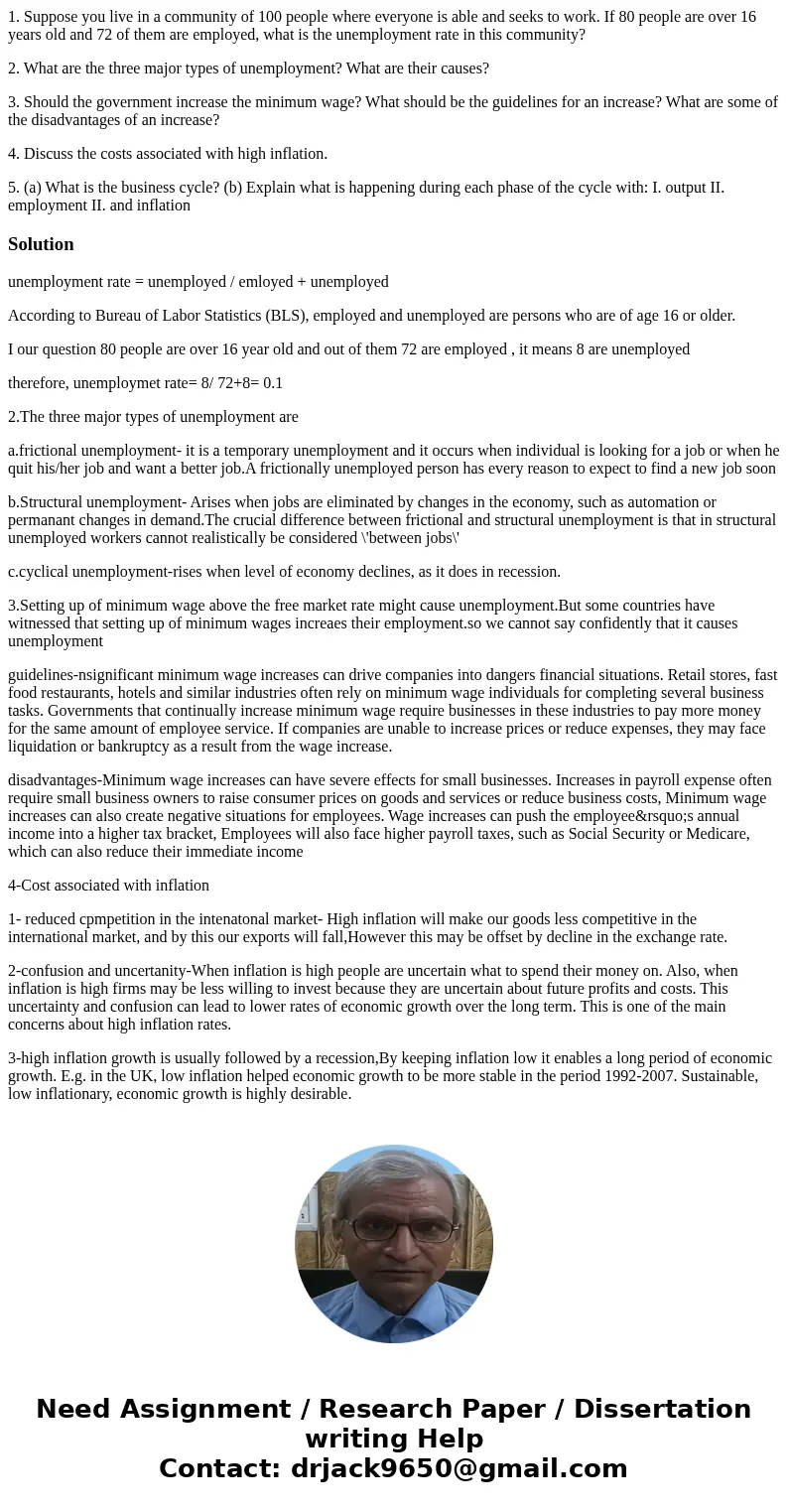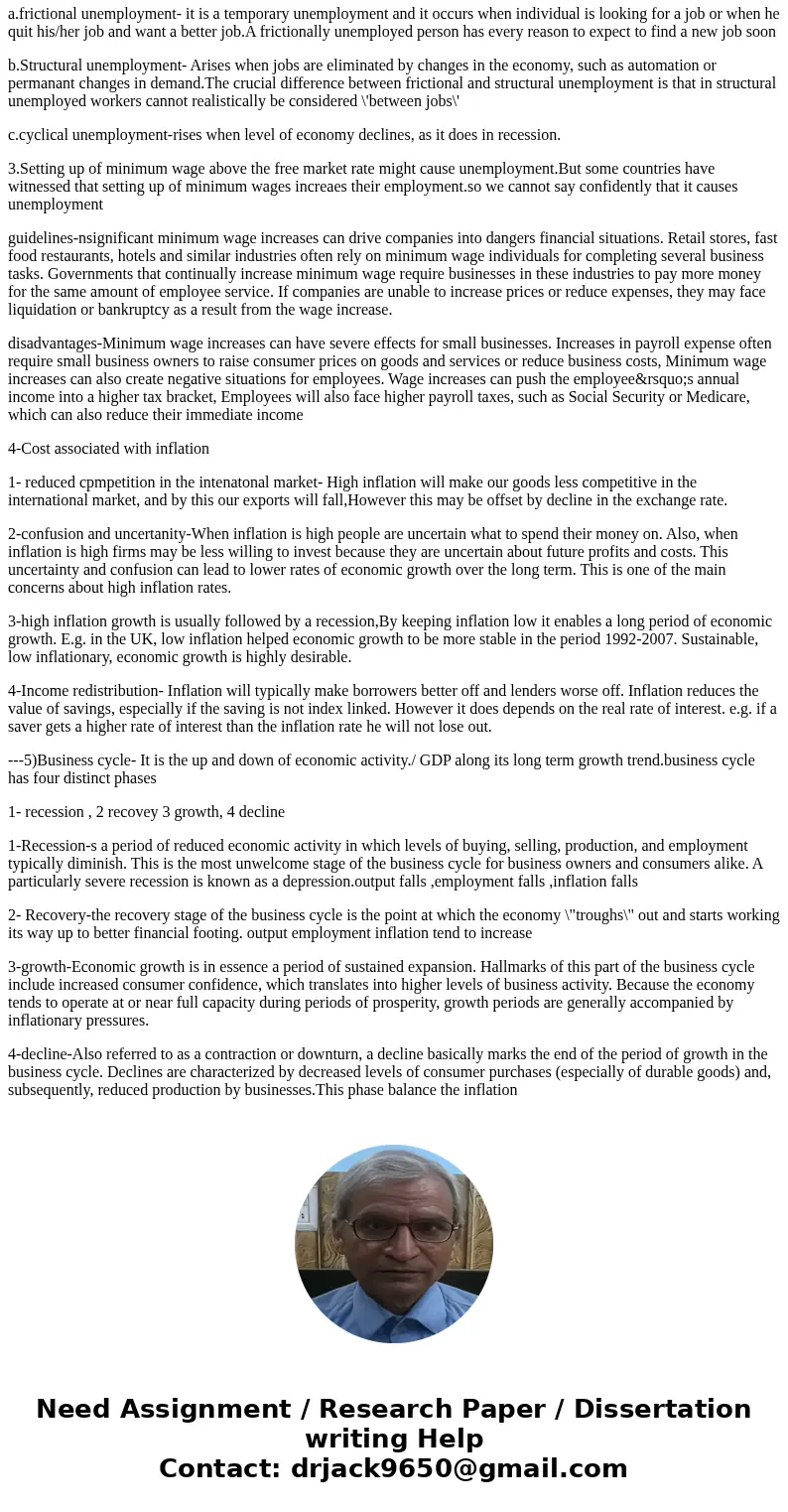1 Suppose you live in a community of 100 people where everyo
1. Suppose you live in a community of 100 people where everyone is able and seeks to work. If 80 people are over 16 years old and 72 of them are employed, what is the unemployment rate in this community?
2. What are the three major types of unemployment? What are their causes?
3. Should the government increase the minimum wage? What should be the guidelines for an increase? What are some of the disadvantages of an increase?
4. Discuss the costs associated with high inflation.
5. (a) What is the business cycle? (b) Explain what is happening during each phase of the cycle with: I. output II. employment II. and inflation
Solution
unemployment rate = unemployed / emloyed + unemployed
According to Bureau of Labor Statistics (BLS), employed and unemployed are persons who are of age 16 or older.
I our question 80 people are over 16 year old and out of them 72 are employed , it means 8 are unemployed
therefore, unemploymet rate= 8/ 72+8= 0.1
2.The three major types of unemployment are
a.frictional unemployment- it is a temporary unemployment and it occurs when individual is looking for a job or when he quit his/her job and want a better job.A frictionally unemployed person has every reason to expect to find a new job soon
b.Structural unemployment- Arises when jobs are eliminated by changes in the economy, such as automation or permanant changes in demand.The crucial difference between frictional and structural unemployment is that in structural unemployed workers cannot realistically be considered \'between jobs\'
c.cyclical unemployment-rises when level of economy declines, as it does in recession.
3.Setting up of minimum wage above the free market rate might cause unemployment.But some countries have witnessed that setting up of minimum wages increaes their employment.so we cannot say confidently that it causes unemployment
guidelines-nsignificant minimum wage increases can drive companies into dangers financial situations. Retail stores, fast food restaurants, hotels and similar industries often rely on minimum wage individuals for completing several business tasks. Governments that continually increase minimum wage require businesses in these industries to pay more money for the same amount of employee service. If companies are unable to increase prices or reduce expenses, they may face liquidation or bankruptcy as a result from the wage increase.
disadvantages-Minimum wage increases can have severe effects for small businesses. Increases in payroll expense often require small business owners to raise consumer prices on goods and services or reduce business costs, Minimum wage increases can also create negative situations for employees. Wage increases can push the employee’s annual income into a higher tax bracket, Employees will also face higher payroll taxes, such as Social Security or Medicare, which can also reduce their immediate income
4-Cost associated with inflation
1- reduced cpmpetition in the intenatonal market- High inflation will make our goods less competitive in the international market, and by this our exports will fall,However this may be offset by decline in the exchange rate.
2-confusion and uncertanity-When inflation is high people are uncertain what to spend their money on. Also, when inflation is high firms may be less willing to invest because they are uncertain about future profits and costs. This uncertainty and confusion can lead to lower rates of economic growth over the long term. This is one of the main concerns about high inflation rates.
3-high inflation growth is usually followed by a recession,By keeping inflation low it enables a long period of economic growth. E.g. in the UK, low inflation helped economic growth to be more stable in the period 1992-2007. Sustainable, low inflationary, economic growth is highly desirable.
4-Income redistribution- Inflation will typically make borrowers better off and lenders worse off. Inflation reduces the value of savings, especially if the saving is not index linked. However it does depends on the real rate of interest. e.g. if a saver gets a higher rate of interest than the inflation rate he will not lose out.
---5)Business cycle- It is the up and down of economic activity./ GDP along its long term growth trend.business cycle has four distinct phases
1- recession , 2 recovey 3 growth, 4 decline
1-Recession-s a period of reduced economic activity in which levels of buying, selling, production, and employment typically diminish. This is the most unwelcome stage of the business cycle for business owners and consumers alike. A particularly severe recession is known as a depression.output falls ,employment falls ,inflation falls
2- Recovery-the recovery stage of the business cycle is the point at which the economy \"troughs\" out and starts working its way up to better financial footing. output employment inflation tend to increase
3-growth-Economic growth is in essence a period of sustained expansion. Hallmarks of this part of the business cycle include increased consumer confidence, which translates into higher levels of business activity. Because the economy tends to operate at or near full capacity during periods of prosperity, growth periods are generally accompanied by inflationary pressures.
4-decline-Also referred to as a contraction or downturn, a decline basically marks the end of the period of growth in the business cycle. Declines are characterized by decreased levels of consumer purchases (especially of durable goods) and, subsequently, reduced production by businesses.This phase balance the inflation


 Homework Sourse
Homework Sourse